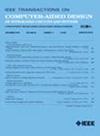Design and Analysis of Optimization Method for Ultra-Wideband PA Based on Improved MOEA/D Algorithm Using Mixed Objective Function
IF 2.9
3区 计算机科学
Q2 COMPUTER SCIENCE, HARDWARE & ARCHITECTURE
IEEE Transactions on Computer-Aided Design of Integrated Circuits and Systems
Pub Date : 2024-12-31
DOI:10.1109/TCAD.2024.3524333
引用次数: 0
Abstract
This article proposes a design and optimization method for Ultra-Wideband power amplifiers (PAs) using improved multiobjective evolutionary algorithm based on decomposition (MOEA/D) and mixed optimization objective function (MOOF). In order to address the insufficient optimization capabilities of conventional MOEA/D algorithm when dealing with complex Pareto fronts, the optimization algorithm is improved by using adaptive weights, neighborhoods, and global replacement. Initially, based on the sparsity of the population and an external population, the weight vectors corresponding to invalid or crowded individuals in the population are replaced. And, the neighborhoods are adaptively adjusted based on the number of iterations and the sparsity of each individual. Then, a global replacement is employed to accelerate the convergence process. Moreover, a MOOF using the load impedance, output power, efficiency and gain is conducted in the PA optimization design. To reduce the difficulty of impedance judgment, a construction method of impedance solution set based on Poisson disk sampling has been proposed and employed for optimization. For validation, an Ultra-Wideband PA operating at 100–4000 MHz (190.2% fractional bandwidth) was designed and optimized. Measured results show a drain efficiency ranging from 56.0% to 70.9% with an output power higher than 39 dBm at saturation within the whole operational frequency band.基于混合目标函数改进MOEA/D算法的超宽带PA优化方法设计与分析
提出了一种基于改进的基于分解的多目标进化算法(MOEA/D)和混合优化目标函数(MOOF)的超宽带功率放大器(PAs)设计与优化方法。针对传统MOEA/D算法在处理复杂Pareto前沿时优化能力不足的问题,采用自适应权值、邻域和全局替换等方法对优化算法进行了改进。首先,基于种群和外部种群的稀疏性,替换种群中无效或拥挤个体对应的权重向量。并根据迭代次数和个体稀疏度自适应调整邻域。然后,采用全局替换来加速收敛过程。此外,还对负载阻抗、输出功率、效率和增益进行了MOOF优化设计。为了降低阻抗判断的难度,提出了一种基于泊松盘采样的阻抗解集构造方法,并进行了优化。为了验证,设计并优化了工作在100-4000 MHz(190.2%分数带宽)的超宽带PA。测量结果表明,在整个工作频段内,漏极效率在56.0% ~ 70.9%之间,饱和输出功率高于39 dBm。
本文章由计算机程序翻译,如有差异,请以英文原文为准。
求助全文
约1分钟内获得全文
求助全文
来源期刊
CiteScore
5.60
自引率
13.80%
发文量
500
审稿时长
7 months
期刊介绍:
The purpose of this Transactions is to publish papers of interest to individuals in the area of computer-aided design of integrated circuits and systems composed of analog, digital, mixed-signal, optical, or microwave components. The aids include methods, models, algorithms, and man-machine interfaces for system-level, physical and logical design including: planning, synthesis, partitioning, modeling, simulation, layout, verification, testing, hardware-software co-design and documentation of integrated circuit and system designs of all complexities. Design tools and techniques for evaluating and designing integrated circuits and systems for metrics such as performance, power, reliability, testability, and security are a focus.

 求助内容:
求助内容: 应助结果提醒方式:
应助结果提醒方式:


